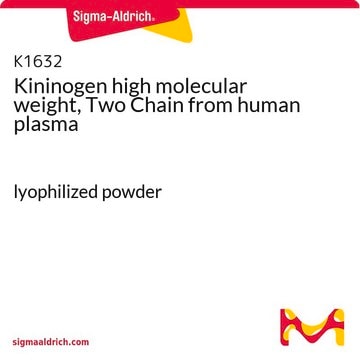K2638
Kallikrein from human plasma
buffered aqueous solution, ≥5 units/mg protein
Synonym(s):
Kininogenase, Kininogenin
Sign Into View Organizational & Contract Pricing
All Photos(1)
About This Item
CAS Number:
MDL number:
UNSPSC Code:
12352204
NACRES:
NA.54
Recommended Products
form
buffered aqueous solution
Quality Level
specific activity
≥5 units/mg protein
UniProt accession no.
shipped in
dry ice
storage temp.
−20°C
Gene Information
human ... KLK1(3816)
Looking for similar products? Visit Product Comparison Guide
General description
Kallikrein-related peptidases belong to the family of 15 highly conserved trypsin- or chymotrypsin-like serine proteases. Plasma kallikrein (PK) is a serine protease derived from plasma prekallikrein, a zymogen found at higher levels in blood circulation. The KLKB1 gene is located on the human chromosome at 4q35.2.
Application
Kallikrein from human plasma has been used:
- to culture human hepatocellular carcinoma cell line
- to study its effects on the cleavage of Neisserial heparin binding antigen (NHBA) from Neisseria meningitidis
- in peptidase inhibition assay
Biochem/physiol Actions
Plasma kallikrein (PK) is involved in the synthesis of bradykinin, maintaining the blood metabolite levels and hypertension. It also participates in the activation of coagulation factor XII, which promotes inflammation and the intrinsic coagulation pathway. PK controls proteolytic cascades in the cardiovascular system like the kallikrein-kinin system, renin-angiotensin system, fibrinolytic system, and the alternative complement pathway. It is involved in the cleavage of glucagon-like peptide-1 (GLP-1) and neuropeptide Y (NPY) which suggests that plasma kallikrein may affect metabolism and diabetes.
Unit Definition
One unit will hydrolyze 1.0 μmole of Nα-benzoyl-L-arginine ethyl ester (BAEE) to Nα-benzoyl-L-arginine and ethanol per min at pH 8.7 at 25°C.
Physical form
Solution in 20 mM Tris-HCl, pH 7.8 with 100 mM NaCl.
Storage Class Code
12 - Non Combustible Liquids
WGK
WGK 1
Flash Point(F)
Not applicable
Flash Point(C)
Not applicable
Personal Protective Equipment
dust mask type N95 (US), Eyeshields, Gloves
Certificates of Analysis (COA)
Search for Certificates of Analysis (COA) by entering the products Lot/Batch Number. Lot and Batch Numbers can be found on a product’s label following the words ‘Lot’ or ‘Batch’.
Already Own This Product?
Find documentation for the products that you have recently purchased in the Document Library.
Customers Also Viewed
Xueqing Xu et al.
Nucleic acids research, 37(22), 7381-7393 (2009-10-13)
A subtelomeric region, 4q35.2, is implicated in facioscapulohumeral muscular dystrophy (FSHD), a dominant disease thought to involve local pathogenic changes in chromatin. FSHD patients have too few copies of a tandem 3.3-kb repeat (D4Z4) at 4q35.2. No phenotype is associated
Elisa Pantano et al.
PloS one, 14(8), e0203234-e0203234 (2019-08-02)
Neisserial Heparin Binding Antigen (NHBA) is a surface-exposed lipoprotein of Neisseria meningitidis and a component of the Bexsero vaccine. NHBA is characterized by the presence of a highly conserved Arg-rich region involved in binding to heparin and heparan sulphate proteoglycans
Allen Clermont et al.
Diabetes, 60(5), 1590-1598 (2011-03-30)
Plasma kallikrein (PK) has been identified in vitreous fluid obtained from individuals with diabetic retinopathy and has been implicated in contributing to retinal vascular dysfunction. In this report, we examined the effects of PK on retinal vascular functions and thickness
R Dellalibera-Joviliano et al.
Scandinavian journal of immunology, 72(2), 128-133 (2010-07-14)
Some components of the kinin system such as plasma kallikrein levels, the activities of tissue kallikrein (including saliva) and kininase II and the concentrations of kininogen fractions (low-molecular weight/LKg and high-molecular weight/HKg) were evaluated in the plasma of patients with
Ekaterina Zubareva et al.
Pharmaceuticals (Basel, Switzerland), 14(11) (2021-11-28)
The disfunction or deficiency of the C1 esterase inhibitor (C1INH) is associated with hereditary or acquired angioedema (HAE/AAE), a rare life-threatening condition characterized by swelling in the skin, respiratory and gastrointestinal tracts. The current treatment options may carry the risks
Our team of scientists has experience in all areas of research including Life Science, Material Science, Chemical Synthesis, Chromatography, Analytical and many others.
Contact Technical Service












